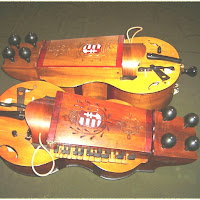| Name | Image | Description | Video |
|---|---|---|---|
| Cimbalom |  | The cimbalom (most common spelling), cymbalom, cymbalum, ţambal, tsymbaly, tsimbl, santouri, or santur is a type of hammered dulcimer found mainly in Hungary, Romania, Moldova, Ukraine, Greece, Poland and Iran. The small cimbalom usually is carried by the musician, using a strap around the player's neck and leaning one edge of the instrument against the player's waist. The cimbalom is played by striking two beaters against the strings. In Hungary, the larger, concert cimbalom, comparable in pitch range (and weight) to a small piano, was first developed by József Schunda in the 1870s. It stands on four legs, has forty-eight strings which are stretched over a large sounding board and sounded with small beaters. | |
| Duda |  | Duda, (also known as tömlösíp and börduda) is a traditional bagpipe of Hungary. The duda’s chanters use single reeds much like Western drone reeds. Duda or dudmaisis are made of sheep, ox, goat or dogskin or of sheep’s stomach. A blowing tube is attached to the top. On one side of the bag is a pipe with fingerholes, on the other side are one or two drone pipes without fingerholes, which play at a single tone. The mouthpieces of the pipes, which have reeds made of goose quill or cane, are usually inside the bag. On the outside end are attached bent horn-shaped tips made of apple or pine wood. | |
| Mišnice |  | The mišnice (also mjeršnice) is an instrument like a bagpipe, made from goatskin. Its date of invention is unknown but it is known to have existed in Europe by the 9th century. Different forms of the instrument were found in North Africa and Eastern Europe, especially Croatia, Serbia, Hungary and Ukraine. It is played by blowing into one pipe while using the fingers to cover or uncover holes in another pipe. It sounds similar to modern bagpipes, but not identical. The chanter, on which the melody is played, is actually a double pipe, with six holes on each side; one set of holes is used as the drone, while the other plays the tune in almost the same register. | |
| Tarogato |  | The tárogató ( Romanian: taragot) refers to two different woodwind instruments, both of them Hungarian. The tárogató has a Persian origin, and it appeared in Hungary during the turkish wars. Up to about the 18th century, the tárogató was a type of shawm, with a double reed, conical bore, and no keys. This instrument is documented as far back as the 15th century. In the 1890s a modern version was invented by Venzel József Schunda, a Budapest instrument maker. It uses a single reed, like a clarinet or saxophone, and has a conical bore, similar to the saxophone. The instrument is made of wood, usually black grenadilla wood like a clarinet. | |
| Tekerőlant |  | The tekerőlant is a small-wheeled Hungarian hurdy gurdy. The wheel diameter is less than 14 cm, or about 5.5 inches. The tekerőlant most commonly has three strings: one melody string, one tenor drone and one bass drone. It sometimes has up to five strings. It has a wedge-adjusted buzzing bridge. The broad keybox is often carved or decorated extensively. The image shows two tekerőlants made by Béla Szerényi. |
Prev Top Next |